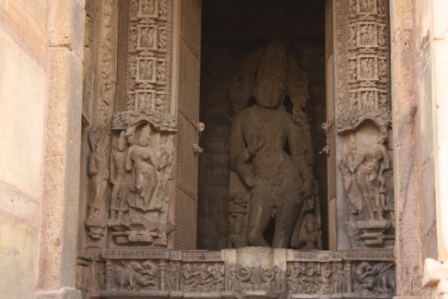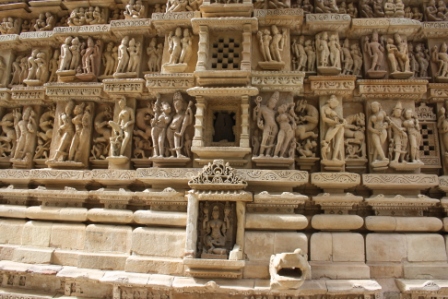The Khajuraho Group of Monuments is a group of Hindu and Jain temples in Madhya Pradesh, India, about 175 kilometres (109 mi) southeast of Jhansi. They are one of the UNESCO World Heritage Sites in India. The temples are famous for their nagara-style architectural symbolism and their erotic sculptures.
Most Khajuraho temples were built between 950 and 1050 by the Chandela dynasty. Historical records note that the Khajuraho temple site had 85 temples by the 12th century, spread over 20 square kilometers Of these, only about 25 temples have survived, spread over 6 square kilometers.[2] Of the various surviving temples, the Kandariya Mahadeva Temple is decorated with a profusion of sculptures with intricate details, symbolism and expressiveness of ancient Indian art.
The Khajuraho group of temples were built together but were dedicated to two religions, Hinduism and Jainism, suggesting a tradition of acceptance and respect for diverse religious views among Hindus and Jains in the region.
The Khajuraho temples feature a variety of art work, of which 10% is sexual or erotic art outside and inside the temples. Some of the temples that have two layers of walls have small erotic carvings on the outside of the inner wall. Some scholars suggest these to be tantric sexual practices. Other scholars state that the erotic arts are part of Hindu tradition of treating kama as an essential and proper part of human life, and its symbolic or explicit display is common in Hindu temples. James McConnachie, in his history of the Kamasutra, describes the sexual-themed Khajuraho sculptures as "the apogee of erotic art"
Most Khajuraho temples were built between 950 and 1050 by the Chandela dynasty. Historical records note that the Khajuraho temple site had 85 temples by the 12th century, spread over 20 square kilometers Of these, only about 25 temples have survived, spread over 6 square kilometers.[2] Of the various surviving temples, the Kandariya Mahadeva Temple is decorated with a profusion of sculptures with intricate details, symbolism and expressiveness of ancient Indian art.
The Khajuraho group of temples were built together but were dedicated to two religions, Hinduism and Jainism, suggesting a tradition of acceptance and respect for diverse religious views among Hindus and Jains in the region.
The Khajuraho temples feature a variety of art work, of which 10% is sexual or erotic art outside and inside the temples. Some of the temples that have two layers of walls have small erotic carvings on the outside of the inner wall. Some scholars suggest these to be tantric sexual practices. Other scholars state that the erotic arts are part of Hindu tradition of treating kama as an essential and proper part of human life, and its symbolic or explicit display is common in Hindu temples. James McConnachie, in his history of the Kamasutra, describes the sexual-themed Khajuraho sculptures as "the apogee of erotic art"

























Loved your blog, waiting for more such blog. Thanks for sharing.
ReplyDeleteBike Rentals in Hyderabad